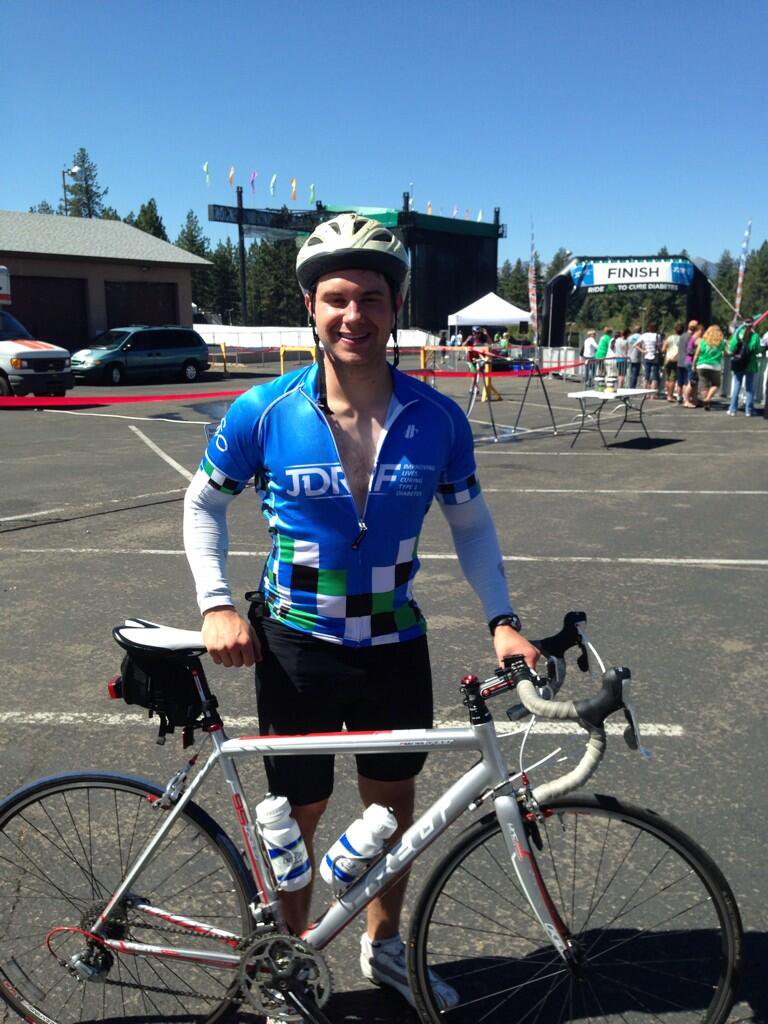3 Diabetes Exercise Questions I Always Ask
By Adam Brown
By Adam Brown
How I avoid highs, prevent lows, and stop blood sugar frustration during exercise
.jpg)
When it comes to diabetes and exercise, timing is everything – food, medication, activity length, time of day, etc. – which demands some planning to keep blood sugars in range. To prevent my head from spinning, I try to break the process down into three simple questions – they’ve helped me cope with the blood glucose complexity and driven far more exercise sessions without lows or highs. Read the approach below from the exercise chapter of Bright Spots & Landmines! (Get the full book here as a free PDF or here on Amazon for $6.)
.png)
What is my BG now? How much do I expect it to change by the time I finish activity? Should I eat or take insulin?
Understanding and preparing for blood glucose (BG) changes during activity is a critical Bright Spot for avoiding lows, highs, and a lot of diabetes frustration. The following three questions take a little planning upfront, but when I go through this thought process, I’m far more likely to stay in range during exercise. The parallels to driving a car – starting destination, ending destination, and road conditions – help me remember the sequence.
1. What is my BG right now? (What is my starting destination?) At least 30 minutes before exercise, I take a fingerstick or check my CGM value and trend arrow. This is no different from inputting my starting destination in Google Maps; I have to know my current location to know the driving route.
2. How much do I expect my BG to change by the time I finish activity? (What is my end destination?) By checking BGs before and after exercise, I have developed some rough personal guidelines for different activities:
|
Activity |
Time |
Approximate BG Change |
|
Walking |
30 mins |
30 mg/dl decrease |
|
Biking/Running |
30 mins |
60 mg/dl decrease |
|
Strength Training |
30 mins |
No change or slight increase (0 to +30 mg/dl) |
(Your guidelines will likely be different, and the “What Helps Me” section below shares tips for developing your own.)
I apply these estimates to my starting BG to get a sense of my expected end destination based on activity alone.
For example, with a starting BG of 150 mg/dl, I know a 30-minute walk might take me to about 120 mg/dl, while a 30-minute bike ride might bring me from 150 mg/dl to about 90 mg/dl. Of course, some days I see bigger or smaller changes than expected, but on average, these guidelines are a Bright Spot for planning safe exercise.

The end destination often needs to change based on any recent food and bolus insulin: carbs within the last hour may increase my ending BG, while bolus insulin within the last two hours is very likely to drive BG lower. That means instead of going from 150 to 120 mg/dl with a 30-minute walk, I might actually end at 140 mg/dl with recent carbs or at 70 mg/dl with recent insulin.
Once I have a rough sense of my expected end destination – including planned activity and any recent food or bolus insulin – I can move on to the last step.
3. Do I need to eat or take some bolus insulin now to: (i) stay in my goal zone of 100-180 mg/dl during exercise; and (ii) finish as close to 100 mg/dl as possible? (What are the road conditions today?) This is my Bright Spot action for avoiding lows and highs: tweaking my food or bolus insulin (driving) before exercise according to the specific circumstances (road conditions) I’m facing on that day.
For example, from a starting BG of 100 mg/dl, a 30-minute bike ride would take me to around 40 mg/dl, a dangerous ending BG. To add some buffer, I’d eat about 15-20 grams of carbs – enough to bring me from my 100 mg/dl start up to around 160 mg/dl, right before 30 minutes of riding drops me back down close to my 100 mg/dl target. (I discuss type of exercise carbs and timing later in the book.)
On the other hand, a very high BG of 250 mg/dl will need a bit of bolus insulin before a 30-minute bike ride, as the exercise alone will only drop me to around 190 mg/dl, which is still higher than my goal. I’d take 1.5 units in that scenario, a 75% reduction over my typical bolus correction dose for a BG of 250 mg/dl.
It’s impossible to nail this guessing game every time, but asking these three questions – what is the starting destination, ending destination, and road conditions – has brought a lot more BG predictability and less frustration to my daily exercise routine. You will have different insulin dose changes and eating approaches, though the questions discussed above will still apply.
At the end of the exercise chapter, I’ve included three very detailed examples that apply these questions step-by-step, along with a summary of exactly how I deal with BGs for different activities.

Develop my own personal guidelines by exercising with a slightly high starting BG (200 mg/dl), but no food or insulin within the past few hours. Morning exercise works well since there are fewer variables in play. The goal is to answer the question, “How much does activity alone (no food or bolus insulin influence) change my BG?” Repeating this experiment a few times is important since the BG change can vary from day to day. Once you have some BG estimates, exercise planning becomes a lot easier.
Wear CGM during exercise to better answer these questions, receive feedback, and inform small changes on the fly (e.g., eat something now?). I often don’t feel low symptoms during exercise, something CGM also helps with.
Exercise has unpredictable effects on BG, particularly when using insulin. Don’t expect perfection. For me, BG changes during exercise seem to differ based on:
-
Time – I often see a smaller BG drop in the morning, when I tend to be more insulin resistant. This can be an advantage when struggling with exercise-related lows, particularly because there are less food and insulin factors to deal with early in the morning.
-
Intensity – Very high-intensity exercise can increase OR decrease blood sugar. It’s hard to predict, so for safety, my default assumption is a BG drop. Those who compete may also see differences between practice (BG drops) and game day (BG increases from adrenaline).
-
What I ate – Eating some protein and fat before activity often keeps my BG more stable than just eating some carbs alone. My food intake for the previous 12 hours also sometimes matters: if I’ve eaten a lot of food on a particular day, I might see steadier BGs than on a day when I’ve barely eaten anything.
Important note: changes in pump basal insulin take about 60-90 minutes to have a meaningful impact on BG, and can still impact BG three or more hours later. I used to suspend my insulin pump instead of eating right before basketball practice, which was completely useless: I would go low during exercise and then high after exercise. Pump basal insulin changes need to come at least one hour before the desired impact on BG. For me, a small amount of food before exercise is a better option for preventing during-exercise lows, since it requires less planning. If food is eaten within 20 minutes of starting activity, I choose carbs that raise BG quickly. (See the Landmine later in the exercise chapter.)
For those on injections, my friends with diabetes recommend predicting activity levels and adjusting basal insulin doses ahead of time. For instance, an inactive day may need more basal in the morning, while an active day may need less basal during the day or overnight.
--
Bright Spots & Landmines: The Diabetes Guide I Wish Someone Had Handed Me is available here as a free/name-your-own-price download. You can also purchase it on Amazon in paperback ($6.29) and Kindle ($1.99). The print book is priced at cost to ensure widespread access, and 100% of proceeds from digital downloads benefit The diaTribe Foundation, a 501(c)(3) non-profit.
Have you benefitted from Bright Spots & Landmines? Could you take a few minutes to write a one-sentence Amazon review sharing your experience? It would help us so much!







